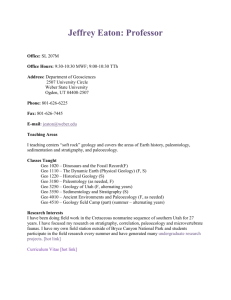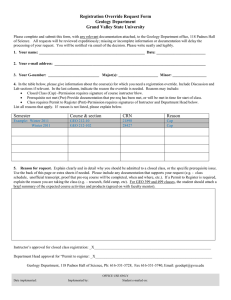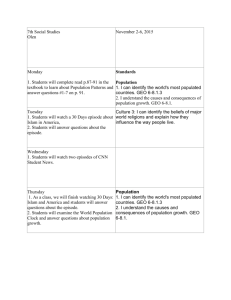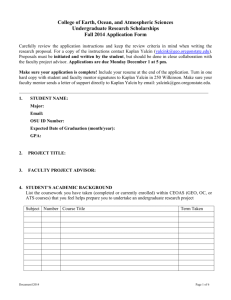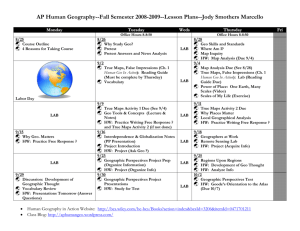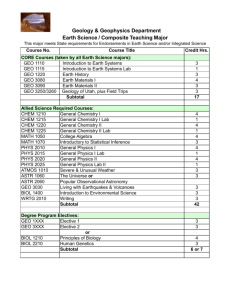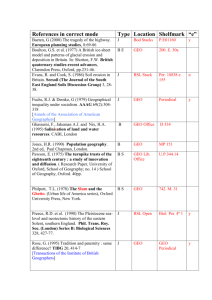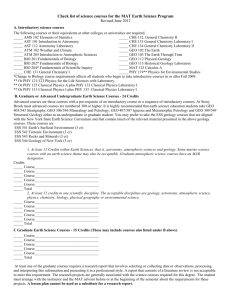quantitative methods in geography/statistics
advertisement
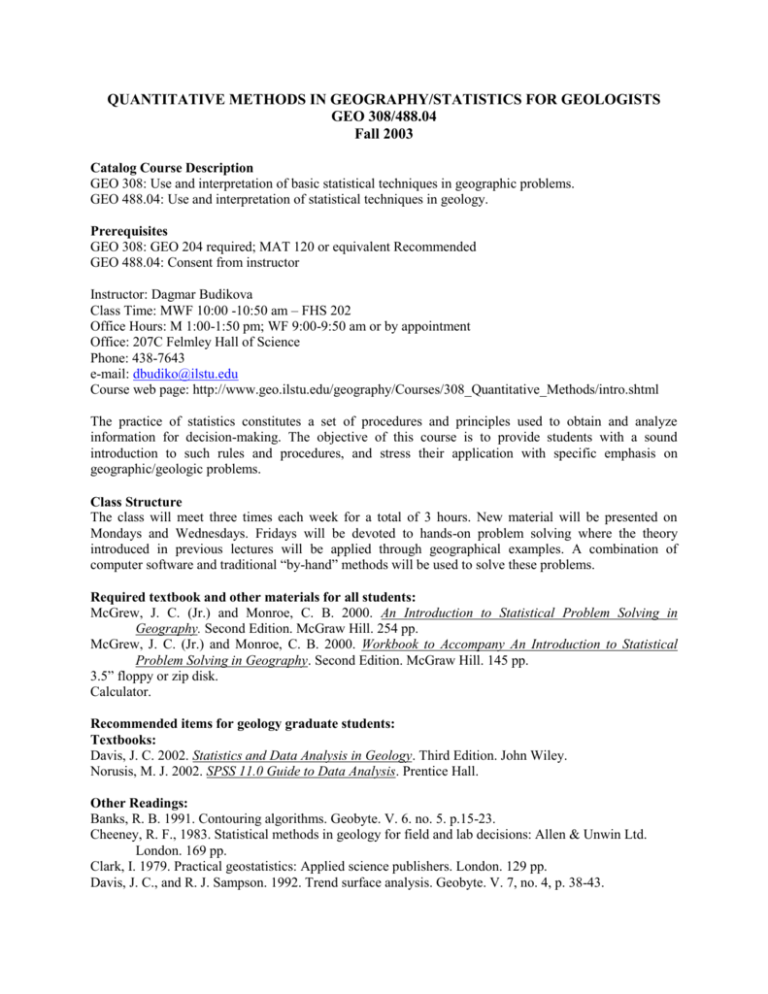
QUANTITATIVE METHODS IN GEOGRAPHY/STATISTICS FOR GEOLOGISTS GEO 308/488.04 Fall 2003 Catalog Course Description GEO 308: Use and interpretation of basic statistical techniques in geographic problems. GEO 488.04: Use and interpretation of statistical techniques in geology. Prerequisites GEO 308: GEO 204 required; MAT 120 or equivalent Recommended GEO 488.04: Consent from instructor Instructor: Dagmar Budikova Class Time: MWF 10:00 -10:50 am – FHS 202 Office Hours: M 1:00-1:50 pm; WF 9:00-9:50 am or by appointment Office: 207C Felmley Hall of Science Phone: 438-7643 e-mail: dbudiko@ilstu.edu Course web page: http://www.geo.ilstu.edu/geography/Courses/308_Quantitative_Methods/intro.shtml The practice of statistics constitutes a set of procedures and principles used to obtain and analyze information for decision-making. The objective of this course is to provide students with a sound introduction to such rules and procedures, and stress their application with specific emphasis on geographic/geologic problems. Class Structure The class will meet three times each week for a total of 3 hours. New material will be presented on Mondays and Wednesdays. Fridays will be devoted to hands-on problem solving where the theory introduced in previous lectures will be applied through geographical examples. A combination of computer software and traditional “by-hand” methods will be used to solve these problems. Required textbook and other materials for all students: McGrew, J. C. (Jr.) and Monroe, C. B. 2000. An Introduction to Statistical Problem Solving in Geography. Second Edition. McGraw Hill. 254 pp. McGrew, J. C. (Jr.) and Monroe, C. B. 2000. Workbook to Accompany An Introduction to Statistical Problem Solving in Geography. Second Edition. McGraw Hill. 145 pp. 3.5” floppy or zip disk. Calculator. Recommended items for geology graduate students: Textbooks: Davis, J. C. 2002. Statistics and Data Analysis in Geology. Third Edition. John Wiley. Norusis, M. J. 2002. SPSS 11.0 Guide to Data Analysis. Prentice Hall. Other Readings: Banks, R. B. 1991. Contouring algorithms. Geobyte. V. 6. no. 5. p.15-23. Cheeney, R. F., 1983. Statistical methods in geology for field and lab decisions: Allen & Unwin Ltd. London. 169 pp. Clark, I. 1979. Practical geostatistics: Applied science publishers. London. 129 pp. Davis, J. C., and R. J. Sampson. 1992. Trend surface analysis. Geobyte. V. 7, no. 4, p. 38-43. Draper, N. R., and H. Smith, 1998. Applied regression analysis. Third Edition. John Wiley & Sons Inc. New York. 706 pp. Ferguson, J., 1988. Mathematics in geology. Allen & Unwin Ltd. London. 299 pp. Haan, C. T. 1977. Statistical methods in hydrology. Iowa State University Press. Ames. Iowa. 378 pp. Jones, T. A., and G. L. Krum, 1992. Pitfalls in computer contouring. Part II: Geobyte. V. 7, no. 4, p. 3137. Ripley, B. D., 1981. Spatial statistics. John Wiley & Sons. Inc. New York. 252 pp. Shafer, R. 2002. The statistical sleuth: A course in methods of data analysis. Second edition. Duxbury. 742 pp. Shaw, G., and D. Wheeler. 1994. Statistical techniques in geographical analysis. Second edition. David Dulton Pulishers Limited. London. 359 pp. Stevens, S.S., 1946. On the theory of scales of measurement: Science. V. 103, p. 677-680. Upton, G. J. G., and B. Fingleton. 1985. Spatial data analysis by example. Volume 1. Point pattern and Quantitative data. John Wiley & Sons Ltd. Chichester U.K. 420 pp. Assignments and Evaluation The total grade of 100% will be portioned in the following manner: Test #1 – September 19, 2003 20% Test #2 – October 31, 2003 Final Exam – December 10, 2003 5 Practical Exercises 30% 10 Quizzes 20% 20% 10% The grading scale for exams and assignments is: 90% A; 80% B; 70% C; 60% D; <60% F Graduate Students In addition to the above requirements, all graduate students will be required to undertake an instructorapproved independent research project. This process will entail posing a hypothesis, obtaining the dataset necessary to test it, and testing the hypothesis using statistical technique(s). Students will prepare two main documents, which include a project proposal due September 19th, 2003, and a final research report, due November 21, 2003. Final grade for graduate students will be computed as follows: Final Grade (%) = 0.7*X + 0.3*Y where X represents the combined score obtained from test #1, test #2, final exam, practical exercises and quizzes as stated above in percent; Y is the grade received on the chosen project in percent. NOTE: In order to pass the course as a whole, you need to receive a passing grade on your project. Both tests will consist of a combination of short-answer, essay, problem-solving and multiple-choice questions. They will be 50 minutes in length each. Each test will include material covered during class and labs. For details see class schedule below. The final exam has been scheduled for Wednesday, December 10, at 7:50 am in FHS205. It will contain material covered since Test #2. Details will be discussed in class. The 5 lab exercises will consist of performing calculations by hand and on computer and answering short-answer questions. Exercises will be due at the beginning of the hour. For details see class schedule below. Once the session begins, the assignment is considered late, and a penalty of 20% is implemented. Thereafter, on each additional date, a penalty of additional 20% is imposed. No late assignments will be accepted after 5 days, unless a legitimate reason is provided to the instructor. Quizzes will be given each Friday at the beginning of class when no test is being written, 10 in total. Each quiz consists of one or more randomly selected homework questions that I will assign during the lectures on Monday and Wednesday. Quizzes cannot be made up. Bonus points: Students are encouraged to attend at least two colloquia talks, or the GGGEO seminars. While listening to the presentation, students should consider several critical aspects of each talk. They should summarize each presentation and critique it. For more information on how to critique a research talk, consult handout given out in class. Consider this very seriously, it may mean the difference between an A and B. Note: Any part of this syllabus is subject to modifications, which will be announced in class.

